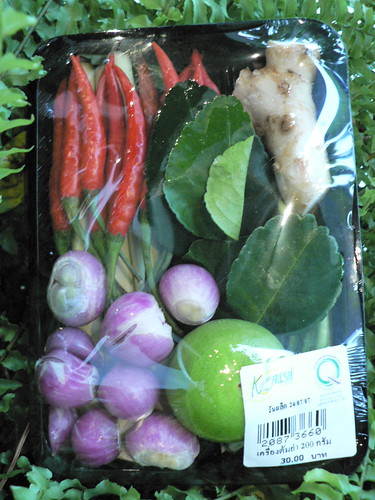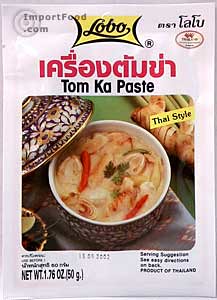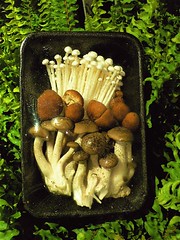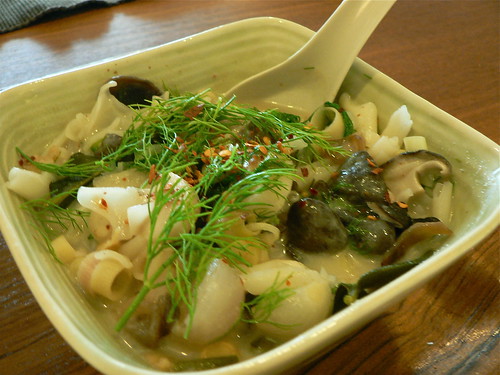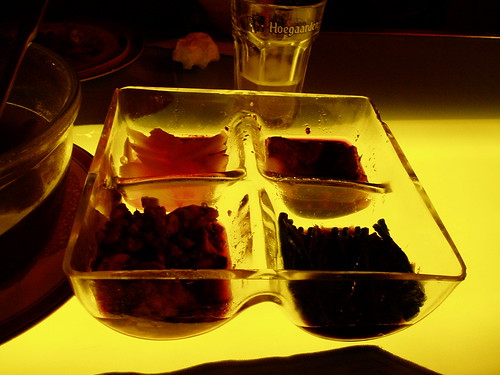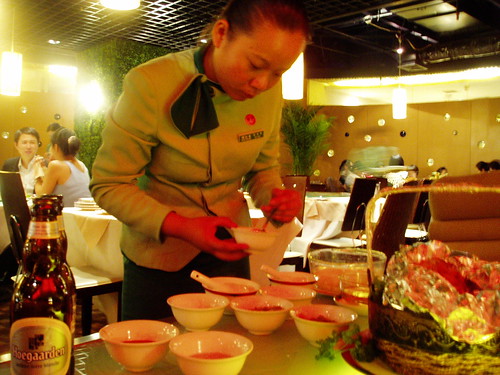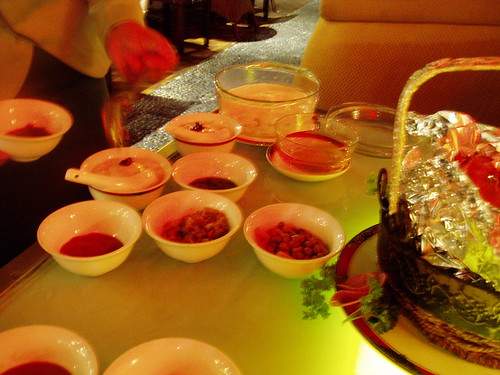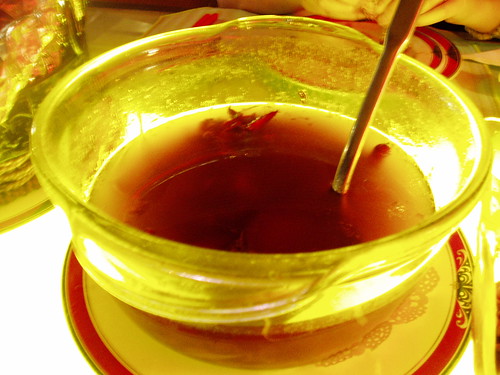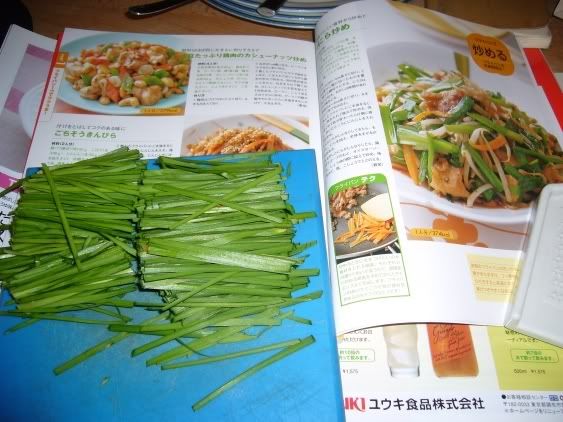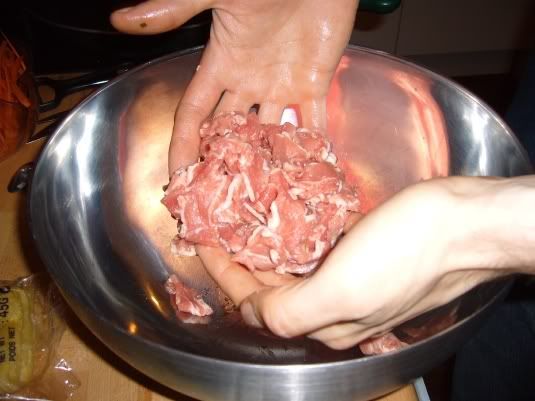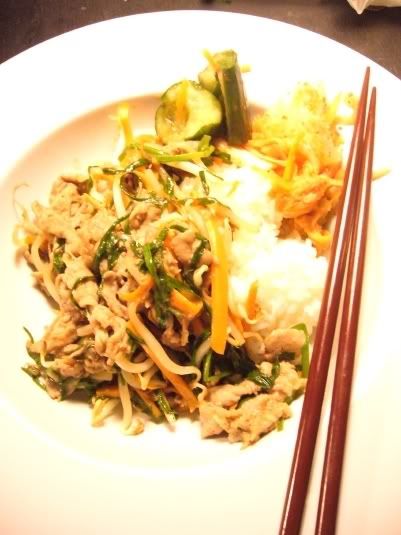
While browsing through this site's tracked google referrals for the first time, I came across
this essay on the bubbling resentment of straight-up Korean kimchi makers towards Japanese manufacturers, who apparently now dominate global kimchi exports.
I became quite taken with the Japanese version of kimchi when I lived there – it's very easy to eat, very more-ish. It is more likely to resemble the milder forms of Korean kimchi, and often has a slight sweetness, which seems to be taken as an affront to Kimchi purists. Now I discover from the above article that Japanese kimchi is often (shock) not fermented!
Koreans want to impose an international Kimchi standard, which in line with the national Korean saying, should perhaps entail stickers saying "tastes like your mother's fingertips".
Explosive AttributesExporting large volumes of such a volatile substance as Kimchi must be dangerous though: we sometimes buy aluminium bags of white kimchi from a korean/Japanese market in Duesseldorf, which contain sachets of a fume-absorbing substance. Once one of these sachets malfunctioned and with trepidation we decided to pierce the dangerously ballooning aluminium bag, taut from all those fermentation gases. Luckily the bag did not explode all over the kitchen, but you can imagine the wonderful odor that clung to us for the rest of the day: "she must be wearing Impulse". Inner energy aptly describes a contained kimchi gaseous cloud.
Like other pickles/preserves, Korean-style Kimchi can be eaten at varying degrees of fermentation (for example, it can be eaten within hours or even seconds after first salting it). However, the longer you leave it alone, the more it is going to ferment – which means that any contained vessel of true Kimchi will attain explosive attributes if it sits on the shelf for long enough.
Recently I've been experimenting with making my own Kimchi - it's quite miraculous how such a simple preparation can yield such complex flavours. I've found that I enjoy quite a mild preparation with a shitload of garlic and spring onions, eaten while still at the crunchier end of the sliminess spectrum.
You can make kimchi with all kinds of vegetables, from cucumbers to soy bean sprouts to radish, turnip etc.
Kimchi LineageThe fermentation process is important though, to produce the probiotic qualities of true kimchi. Kimchi, like German sauerkraut, is descended from Chinese kimchi, which was cabbage fermented in rice wine. According to one site, it was eaten about 2000 years ago by the men who were building the Great Wall of China.
According to some sources, sauerkraut owes its origins to Genghis Kahn, who after plundering the Chinese brought the recipe for Ji or Kimchi to Eastern Europe. The Europeans eliminated the rice wine and used salt to ferment. A century or two later, the introduction of red pepper to Korea by Spanish and Portuguese traders (at roughly the same time it was introduced to China and Japan), in the 17th century, brought a major innovation to kimchi and to the Korean diet in general. Maybe we should put down our weapons and accept that it's one big global kimchi party.
Rotten ProbioticsMost store-bought sauerkraut I've eaten in Germany does not have the riper fermented attributes of store-bought korean kimchi, so one would assume, it contains less probiotic substances.
Of course, one could make kimchi at home and eat it before it ferments. In general though, korean kimchi made from cabbage seems to be more volatile than Sauerkraut when packaged on the supermarket shelves.
Here's what thenibble.com says about the probiotic qualities of pickled cabbage – as you'll see, there's also some controversy over what consitutes real sauerkraut:
"Whether it’s sauerkraut in Germany, kimchi in Asia (especially Korea), cortido or curtido in Central America, or choucroute in France, fermented cabbage is consumed wherever cabbage itself can be grown. A head of cabbage can be sliced before fermentation, but it may also be left whole. Unlike probiotic-containing foods that start from a dairy base, cabbage does not need bacteria added to it to begin the fermentation process. All you need to add, in fact, is salt (the addition of vinegar is looked upon with contempt by makers of “true” sauerkraut, who declare that it’s used only by those who don’t take the time to go through a full fermentation process and want a cheap and quick way to achieve acidity). With the correct level of salinity (about 1.5%) and at a proper temperature (temperature is important to every fermentation process–just ask your local brewer!), the cabbage will ferment. Several different bacteria will be at work during this process, as you might expect, and those bacteria change as the acidity of the brine surrounding the cabbage increases. The most commonly cited probiotic associated with sauerkraut is Lactobacillus plantarum. Many fermented cabbage products commercially available have been pasteurized; such treatment with heat will destroy any friendly bacteria.
If fermentation was not halted, the sauerkraut containers would swell or explode; (...) any active fermentation process will produce gases. The preservative sodium benzoate, often added to sauerkraut and other fermented vegetables, will also kill friendly bacteria. Any of these brands (or any others) must be in refrigerated form if you’re looking for live cultures, and check the label to make sure no sodium benzoate has been added."
I have checked out the supermarket-available brands of sauerkraut here in Germany and most do contain additives. We have had a foil package of sauerkraut (the own-brand from the organic store Biomarkt) in the bottom of our fridge - and the ingredients are listed as only white cabbage and salt. But that packet has been sitting in our fridge forever and it has not swollen, even a little bit. In fact the date stamp says it will be good until March 2009...which means a shelf life of approximately 2 years?? That organic sauerkraut simply must've been pasteurised in some way shape or form...
Sleeping with the enemyGetting back to the taste of kimchi, rather than the funkiness- or healthiness-quotient: when a trip to Duesseldorf for a dangerous, smelly pottle of store-bought fermented kimchi is not possible, and I haven't had the time to chop up soya sprouts, daikon, cabbage leaves and salt them and mix them with chilli powder and garlic, we rely on a gas-free Japanese brand of 'kimchi base' sauce. Rather like the 'Heinz ketchup' variety of kimchi, it keeps well in the fridge and can be utilised to make instant kimchi-flavoured chopped cucumbers, crunchy but pungent and delicious when eaten with good short grain rice. A very satisfying meal in itself, and also excellent with Japanese-style burgers. The base of course is also great added to hot pots and so on.
Turns out I quite like the flavour of artificial food additives, citric acid and xanthan gum.

